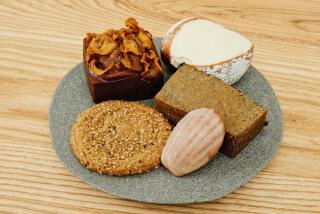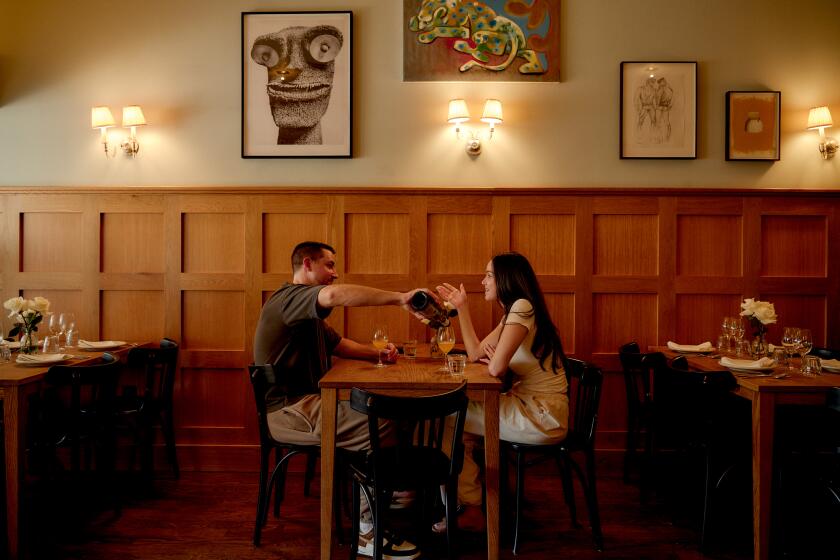Too Cool for Coffee? : Relax. With rooms popping up almost every month, tea is hot in Southern California.
In their search for the Next Big Thing, Southern Californians have been prone to designer water, overpriced pizza and wireless communication.
But this Next Big Thing is something even grandma could cozy up to:
Tea.
It’s warm, nutritious and mellow--we know. But sipping a steaming pekoe is also as de rigueur these days as downing a double-caffeinated cappuccino. Chado Tea Room in West Hollywood, for one, is open till midnight on Fridays and Saturdays, serves up four-speaker sound and encourages patrons to “invite someone dangerous to tea.”
Laid-back tea-serving establishments are cropping up in Southern California at the rate of roughly one per month--perhaps as part of a health kick that prompted the popularity of coffee in lieu of alcohol.
Many of those who frequent the 60 or so tea spots in Southern California are, in fact, caffeine refugees: Tea has less than half the caffeine and calories as coffee. “Coffee people are more aggressive,” says Melissa Robke, a 35-year-old tea-room regular who drinks both beverages. “Tea people are more refined.”
The latest wave of tea-sipping spots differ noticeably from Southern California’s longstanding high-tea salons, where women are ladies, men are gentlemen and biscuits are scones: They’re artsy hang-outs for the lunch, dinner and early-evening crowds.
Chado owner Suity Liongosari, in baby-doll jumper and low-cut combat boots, says her small, 2-year-old room on West 3rd Street “is almost like a coffee shop.”
At Frills, a combination thrift store and tearoom in Monrovia (and soon in Temecula, too) customers are encouraged to play dress-up with hats and feather boas. “The occasional gentleman who wanders in seems to like that, too,” a store manager insists.
Across the continent, customers of 6-month-old T in New York’s SoHo District can get sushi with their tea, pastries with tea cream and even chicken infused with tea. “It’s like a tea galaxy,” a worker says.
The trend has blessed coffeehouses that serve tea, as well as a few traditional salons. At Tea and Sympathy in Costa Mesa, where formal, afternoon tea has been served for 15 years, sales are up 25% over 1992. “Tea’s becoming an ‘in’ thing to do,” owner Nancy Williams declares.
The phenomenon is a long way from the day in 2737 BC when a Chinese emperor discovered the drink. A breeze tossed a few tea leaves into his cup of hot water, according to legend. The English discovered tea around 1615 and monopolized the market. That angered the Colonies in America, especially when the British gained sole access to burgeoning Colonial tea sales through the Tea Act of 1773.
What followed might have changed America’s drinking habits for the next two centuries: The Boston Tea Party--a revolt that had the locals dumping British tea into Boston Harbor. Shortly after that, the Declaration of Independence was signed and tea was relegated as a bastard beverage--save for the ever-popular iced variety.
Ironically, tea is the most popular beverage in the world--drink of choice to half its population. And it’s the cheapest beverage around, next to water.
Tea, both hot and iced, comes from the leaves of the tea plant, taxonomically known as Camellia sinensis . The plant produces three basic kinds of tea: black (fermented and full-flavored), oolong (semi-fermented and slightly bitter) and green (unfermented and also slightly bitter). There’s also herbal tea (actually herbs brewed like tea). And gourmet blends of tea include everything from paprika to popcorn.
Chado offers 250 gourmet blends--including rhubarb iced tea for summer--straight out of brown canisters on a mahogany wall rack. “It’s like wine,” owner Liongosari says.
Not exactly. Even the best tea is relatively cheap. Take a blend favored by the Queen of England that was once featured at Chado. It retailed for $11 a dry ounce--enough to make almost four pots. And tea servers can usually clear more than $2 profit from a $2.50 cup of tea.
On the other hand, because tea is cheap and goes a long way, it’s hard to make money without a stampede of customers. Many shop owners subsidize their passion for the brew with adjacent gift shops, antique stores and--gasp--coffee sales. “You gotta find a gimmick because these tearooms are popping up everywhere,” says the owner of the soon-to-open la-TEA-da in Arcadia, another place that encourages customers to dress up in hats and boas.
*
No one knows for sure what fueled the fad. The predominant theory says people are burned out on high-potency coffee. Another says the trend is one of many side effects from the decade-long decline of alcohol intake. One shop owner says people are more well-traveled and want to re-create atmospheres they experienced in Europe (such as coffeehouses).
Diana Rosen, publisher of a Westside-based national quarterly called Tea Talk, says renewed trade with China--the tea-growing capital of the world--is a factor. “Connoisseurs are buying rare, legendary tea that is only now available,” she says.
Meanwhile, the coffee crowd--always alert to these things--is using a join-’em approach. The Novel Cafe in Santa Monica recently added 12 blends to its menu of 26 teas: “It’s a nice complement to coffee,” owner Richard Karno says.
The Long Beach-based Specialty Coffee Assn. of America, a group that represents coffeehouses and coffee producers nationwide, is thinking about forming a tearoom branch.
And Starbucks spokeswoman Laura Moix points out that the megachain of coffeehouses has served tea since the day the first Starbucks opened in 1971. “If we saw an increase in popularity, we would probably offer a wider selection of teas,” she adds.
*
Tea fanatics swear their brew has superior attributes--everything from male vitality to spiritual healing. Yogi Tea--a health-food store staple that is now the rage at area tea and coffee spots--has a line of herbal “ancient healing formulas” that vow to vanquish the flu or doctor the digestive system.
One coffeehouse worker says tea works as an aphrodisiac. “I bumped into this girl, invited her up for tea and . . . hook, line and sinker,” says 24-year-old Jeffrey Pinchuk of Congo Square Espresso & Tea House in Santa Monica.
UCLA nutritionist Judith M. Ashley can’t confirm such claims: “We don’t have a lot of research to back that up.” Then again, Ashley can confirm that there is a correlation between plain black and green tea and lower rates of cancer. “I prefer the tea over coffee,” she adds.
Back at Chado, sales are slow on a sweltering afternoon. Two people lounge in the intimate, purple-walled room, only a storefront window away from traffic sounds and parking wars. Customer Angie Bray laments the coming changes.
“I was very disappointed,” she says, “when they put up a sign that said they were going to serve coffee.”
More to Read
Eat your way across L.A.
Get our weekly Tasting Notes newsletter for reviews, news and more.
You may occasionally receive promotional content from the Los Angeles Times.








